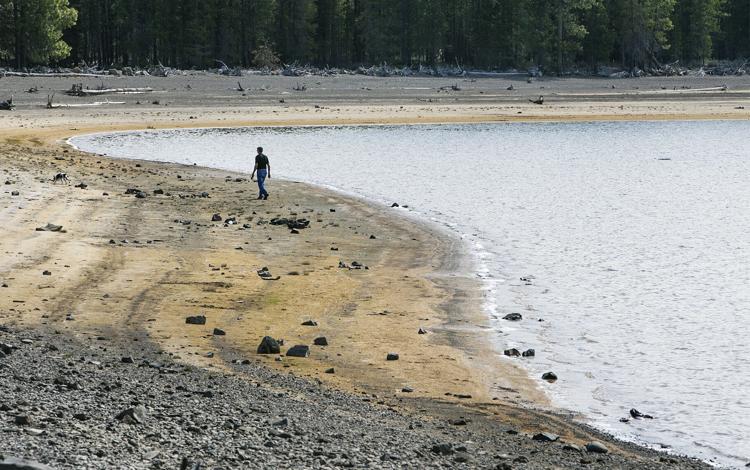This article was published on: 06/22/21 2:07 PM
Wickiup Reservoir has fallen to just 22% full, and were not even in July yet
Mike Britton has seen his fair share of irrigation seasons. He has been in charge of North Unit Irrigation District since 2008, guiding water use on farms in Jefferson County, Central Oregon’s most productive farmland. But this year has been particularly challenging.
As of Monday, Wickiup Reservoir, which holds most of North Unit’s stored water, was just 22% full. In a normal year, the reservoir would contain three times the current amount of water.
That matters because when the reservoir reaches extremely low levels, which is expected to happen by mid-August, water may not be available for farmers to irrigate their crops until the end of the season. It leaves crops vulnerable and puts livelihoods on the line.
Britton said the water situation soured over the course of the exceptionally dry spring. Water allotments for North Unit users — 1 acre-foot for the Deschutes River and half an acre-foot for the Crooked River — were set in March when the snowpack was over 100% of normal and precipitation around 85% of normal.
“It felt pretty good going into the irrigation season with our allotment,” said Britton. “But the melted snow didn’t make it down the reservoirs and streams (and) we got no other significant precipitation since early March or April, so that really hurt us with our water supply, which shows in Wickiup.”
Usage slow down
While Wickiup has never been this low so early in the irrigation season, Britton said the rapid draining of the reservoir could slow down in the coming weeks as some farmers run out of their water allotment. While all patrons start with the same allotment, water is used differently, and patrons will run out at different times.
“People are going to be running out of water if they haven’t already, which means there will be less demand on Wickiup in the system,” said Britton. “Some people will fallow fields and move water around, which gives them flexibility. For those who can’t do that, they are done for the season.”
Farmers who use their water sparingly should have some water until early October, the end of the irrigation season, said Britton
Britton added that a few good thunderstorms could help, too. When rain falls, farmers shut down their irrigation systems, allowing them to spread out their water allotment.
Kyle Gorman, district manager for the Oregon Water Resources Department, said Wickiup will also get a little boost of water in July when 10,000 to 15,000 acre-feet of water are released from Crane Prairie Reservoir, upstream from Wickiup.
Gorman added that the extremely low levels of water do not necessarily mean Wickiup will go completely dry as it did a year ago. That’s because irrigation districts are considering an option to leave some water in the bottom of Wickiup. The proposal would leave around 2,500 acre-feet in the reservoir to prevent the silty water that occurred after Wickiup ran out of water last year.
In September, brackish water ran out of Wickiup when the Deschutes River picked up silt from the bottom of the reservoir. Gorman expects the reservoir to reach its lowest level by mid-August.
Water rotation
Tumalo Irrigation District, which takes water out of Tumalo Creek, will be implementing a seven-day -on and seven-day -off rotation for its patrons. By doing so, it expects to have water until the end of the irrigation season, said Chris Schull, the district’s interim manager.
Colin Wills, head of the Arnold Irrigation District, said his patrons are also in conservation mode and getting water on a rotating basis. Typically 90 cubic feet of water per second flows through the district’s canal. Currently, that number is just 55 cubic feet per second.
“As a result, I don’t expect us to use our full water rights this year, nor run into any shortages,” said Camarata.
He added that the conservation measures may even allow the district to have a surplus of water, which can be transferred to junior water rights holders or can be left in-stream to improve fish habitat.
“The piping modernization projects are already paying off,” he said.
Shifting water
Another district that is better positioned to handle the drought, due to its status as a senior water rights holder, is Central Oregon Irrigation District. Craig Horrell, head of the district, does not anticipate an early shut-off and has even started a water-sharing program with junior rights holders. The program will shift 100 cubic feet per second away from the Central Oregon district to North Unit, Arnold and Lone Pine districts.
“As a senior water right holder, we have the unique ability to increase water reliability for our neighboring irrigation districts and their irrigation users, while continuing to deliver water to our patrons,” said Horrell.
Some Central Oregon Irrigation District patrons are reaching out to offer their water to farmers in need. Shon Rae, deputy managing director for the district, said 10 patrons with a total of 64 acres have offered to share their water.
One thorny question remains: What is the quickest way to get Wickiup filled again? Gorman believes that the current plan to pipe the canals and implement conservation projects is still the best option.




